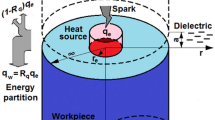Abstract
In this paper, an inverse heat conduction method is applied to estimate the amount of the energy (F c ) transferred to the workpiece during electric discharge machining (EDM) process. Embedded thermocouples which were connected to a four channel data logger were utilized to measure the temperature of a specific location on a rectangular workpiece during the EDM process. After temperature measurements were done, the 2-D heat conduction model of the workpiece and the Levenberg-Marquardt (LM) scheme were used to determine the energy transferred to the workpiece. This inverse procedure facilitates the determination of the heat energy at discharge-workpiece interface in EDM processes, which yet is a challenge for existing numerical models. The obtained results showed that the energy transferred to the workpiece varies with the discharge current and pulse duration from 5 % up to 45 %, which shows that the value of F c is a function of discharge current and pulse duration and that the fixed value of energy assumed in majority of the previous researches is not in accordance with real EDM conditions. Furthermore, the effects of machining parameters such as discharge current and pulse duration on F c were studied. It was evident that the F c has a direct but non-linear relationship with both discharge current and pulse duration, while discharge current has a higher impact on F c .
Similar content being viewed by others
References
Yeo SH, Kurnia W, Tan PC (2008) Critical assessment and numerical comparison of electro-thermal models in EDM. J Mater Process Technol 203:241–251
Izquierdo B, Sánchez JA, Plaza S, Pombo I, Ortega N (2009) A numerical model of the EDM process considering the effect of multiple discharges. Int J Mach Tools Manuf 49:220–229
Snoeys R, Van Dijck F, Peters J (1972) Plasma channel diameter growth affects stock removal in EDM. CIRP Annals 21:39–40
Van Dijck FS, Dutré WL (1974) Heat conduction model for the calculation of the volume of molten metal in electric discharges. J Phys D Appl Phys 7:899
Beck JV (1981) Large time solutions for temperatures in a semi-infinite body with a disk heat source. Int J Heat Mass Transf 24:155–164
Beck JV (1981) Transient temperatures in a semi-infinite cylinder heated by a disk heat source. Int J Heat Mass Transf 24:1631–1640
Tariq Jilani S, Pandey PC (1983) An analysis of surface erosion in electrical discharge machining. Wear 84:275–284
Pandey PC, Jilani ST (1986) Plasma channel growth and the resolidified layer in edm. Precis Eng 8:104–110
Singh H, Shukla DK (2012) Optimizing electric discharge machining parameters for tungsten-carbide utilizing thermo-mathematical modelling. Int J Therm Sci 59:161–175
DiBitonto DD, Eubank PT, Patel MR, Barrufet MA (1989) Theoretical models of the electrical discharge machining process. I. A simple cathode erosion model. J Appl Phys 66:4095–4103
Eubank PT, Patel MR, Barrufet MA, Bozkurt B (1993) Theoretical models of the electrical discharge machining process. III. The variable mass, cylindrical plasma model. J Appl Phys 73:7900–7909
Kunieda M, Lauwers B, Rajurkar KP, Schumacher BM (2005) Advancing EDM through fundamental insight into the process. CIRP Ann Manuf Technol 54:64–87
Joshi SN, Pande SS (2010) Thermo-physical modeling of die-sinking EDM process. J Manuf Process 12:45–56
Singh H (2012) Experimental study of distribution of energy during EDM process for utilization in thermal models. Int J Heat Mass Transf 55:5053–5064
Zahiruddin M, Kunieda M (2012) Comparison of energy and removal efficiencies between micro and macro EDM. CIRP Ann Manuf Technol 61:187–190
Fonda P, Wang Z, Yamazaki K, Akutsu Y (2008) A fundamental study on Ti–6Al–4V’s thermal and electrical properties and their relation to EDM productivity. J Mater Process Technol 202:583–589
H.D. Baehr, K. Stephan, H.D. (2006) Baehr, Heat conduction and mass diffusion, Heat Mass Transfer 105-251
Beck JV, Blackwell B, St Clair CR (1985) Inverse heat conduction: ill-posed problems. A Wiley-Interscience, New York
Ozisik MN, Orlande HRB (2000) Inverse heat transfer: fundamentals and applications. Taylor & Francis, London
Taler J, Duda P (2006) Solving direct and inverse heat conduction problems. Springer, Verlag Berlin Heidelberg
Debnath L (2007) Linear partial differential equations for scientists and engineers. Springer, Verlag Berlin Heidelberg
Dennis JE Jr, Schnabel RB (1996) Numerical methods for unconstrained optimization and nonlinear equations. Siam, Philadelphia
Author information
Authors and Affiliations
Corresponding author
Rights and permissions
About this article
Cite this article
Shabgard, M., Akhbari, S. An inverse heat conduction method to determine the energy transferred to the workpiece in EDM process. Int J Adv Manuf Technol 83, 1037–1045 (2016). https://doi.org/10.1007/s00170-015-7651-8
Received:
Accepted:
Published:
Issue Date:
DOI: https://doi.org/10.1007/s00170-015-7651-8



